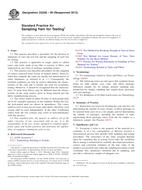Potřebujeme váš souhlas k využití jednotlivých dat, aby se vám mimo jiné mohly ukazovat informace týkající se vašich zájmů. Souhlas udělíte kliknutím na tlačítko „OK“.
ASTM D2258-99(2012)
Standard Practice for Sampling Yarn for Testing
Automaticky přeložený název:
Standardní praxe pro odběr vzorků příze pro testování
NORMA vydána dne 1.3.2012
Informace o normě:
Označení normy: ASTM D2258-99(2012)
Poznámka: NEPLATNÁ
Datum vydání normy: 1.3.2012
Kód zboží: NS-19815
Počet stran: 4
Přibližná hmotnost: 12 g (0.03 liber)
Země: Americká technická norma
Kategorie: Technické normy ASTM
Kategorie - podobné normy:
Anotace textu normy ASTM D2258-99(2012) :
Keywords:
sampling, yarn , Sampling textiles, ICS Number Code 59.080.20 (Yarns)
Doplňující informace
| Significance and Use | ||||||||||
|
Assigning a value to any property of the material in a container or in a lot, consignment, or delivery involves a measurement process that includes both sampling and testing procedures. The correctness of the value assigned depends upon the variability due to testing. Even when the variability due to testing is minimized by carefully developed procedures, correct and consistent estimates of the true value of the property are possible only when the sampling procedure avoids systematic bias, minimizes variations due to sampling, and provides a laboratory sample of adequate size. Practice D2258 may not give the most efficient sampling plan that might be devised in special situations but does present a general procedure that gives satisfactory precision with an economical amount of sampling and one which does not require elaborate statistical computation based on previous knowledge of the amount of variation between primary sampling units (such as cases, beams or fabric packages), between units of the laboratory sample taken from the primary sampling units of the lot sample (such as yarn packages taken from a case) and between specimens taken from units of the laboratory sample (such as lengths of yarn taken from a yarn package or a fabric swatch taken from a roll or piece). Many plans that include stratified sampling can be found in textbooks. The smallest number of specimens required for a given variability in the average result will usually be obtained by (1) maximizing the number of shipping containers in the lot sample, (2) taking a single package end per shipping container in the laboratory sample, and (3) taking only one specimen per package. Unfortunately, this is rarely the most economical way to test a product because it normally costs most to take a shipping container as part of the lot sample, costs an intermediate amount to take a package from a shipping container as part of a laboratory sample, and costs least to take and test a specimen from a package or yarn. To minimize the cost of sampling a lot of material, it is necessary to agree on the required variance for the reported average for a lot of material: Estimate the variance due to lot samples, the variance due to laboratory samples, and the variance due to testing specimens. Calculate the total variance for average test results for several combinations of the number of lot samples, the number of laboratory samples per lot sample, and the number of specimens per laboratory sample. Calculate the cost of performing each of the sampling schemes considered in 5.4.2. Select the sampling scheme that ( 1) has the required precision and (2) is most economical to perform. |
||||||||||
| 1. Scope | ||||||||||
|
1.1 This practice describes a procedure for the division of shipments of yarn into test lots and the sampling of such lots for testing. 1.2 This practice is applicable to single, plied, or cabled yarns, and cords, made of any fiber or mixture of fibers, and supported on any form of package, including beams. 1.3 This practice also describes procedures for the sampling of yarn(s) removed from woven or knitted fabrics, however, when thus sampled, the yarns are usually not representative of entire shipments, as referred to in 1.1. Consequently, the resultant sampling can only be used to determine the characteristics of the yarn and is usually not used for acceptance testing. Moreover, it should be recognized that the characteristics of yarns from fabrics may be different than the characteristics of the same yarn(s), prior to being entered into the fabric manufacturing process. 1.4 The values stated in either SI units or inch-pound units are to be regarded separately as the standard. Within the text, the inch-pound units are shown in parentheses. The values stated in each system are not exact equivalents; therefore, each system shall be used independently of the other. Combining values from the two systems may result in nonconformance with this practice. 1.5 This standard does not purport to address all of the safety concerns, if any, associated with its use. It is the responsibility of the user of this standard to establish appropriate safety and health practices and determine the applicability of regulatory limitations prior to use. |
||||||||||
| 2. Referenced Documents | ||||||||||
|
Podobné normy:
Historická
1.7.2012
Historická
1.12.2011
Historická
1.7.2012
Historická
15.9.2007
Historická
1.5.2011
Historická
1.7.2013
Doporučujeme:
EviZak - všechny zákony včetně jejich evidence na jednom místě
Poskytování aktuálních informací o legislativních předpisech vyhlášených ve Sbírce zákonů od roku 1945.
Aktualizace 2x v měsíci !
Chcete vědět více informací? Podívejte se na tuto stránku.



 ASTM D5647-07(2012)..
ASTM D5647-07(2012).. ASTM D6197-99(2011)..
ASTM D6197-99(2011).. ASTM D6587-12e1
ASTM D6587-12e1 ASTM D6611-00(2007)..
ASTM D6611-00(2007).. ASTM D6612-00(2011)..
ASTM D6612-00(2011).. ASTM D6613-08(2013)..
ASTM D6613-08(2013)..
 Cookies
Cookies
